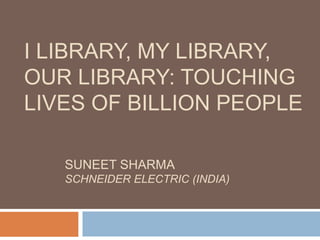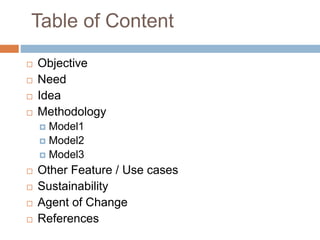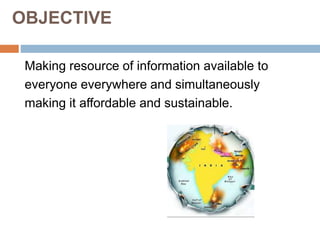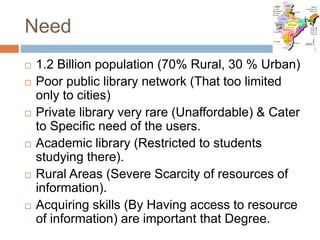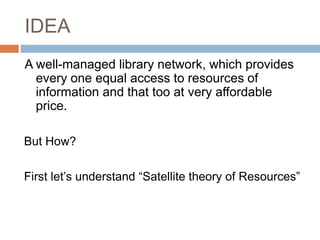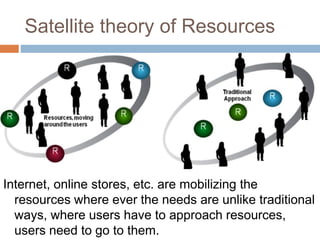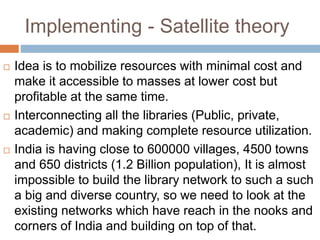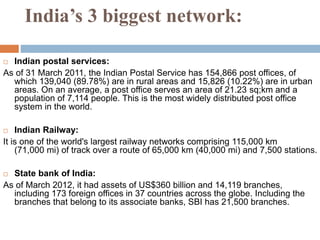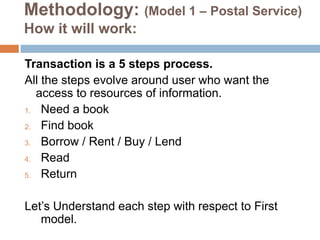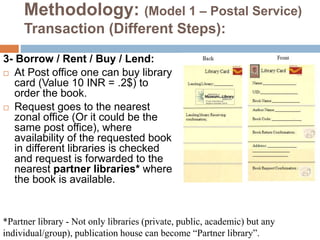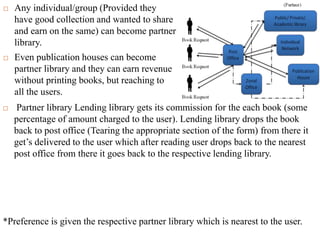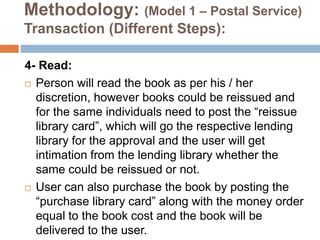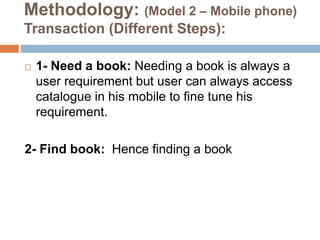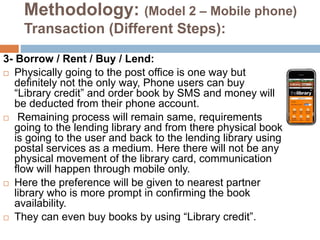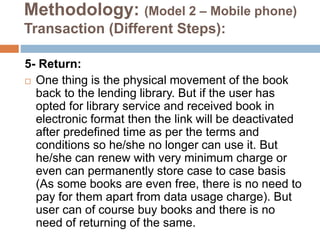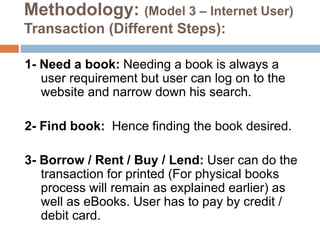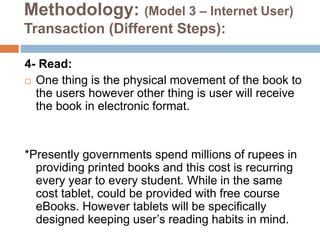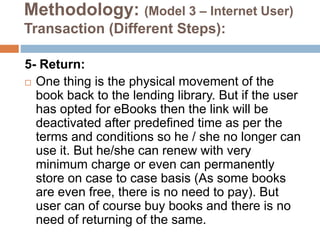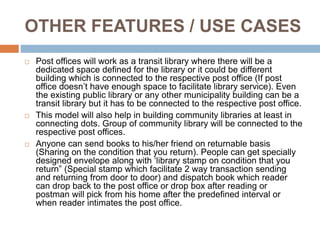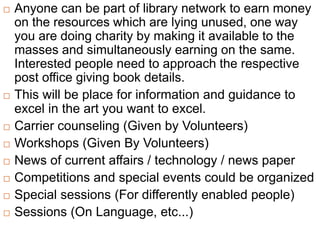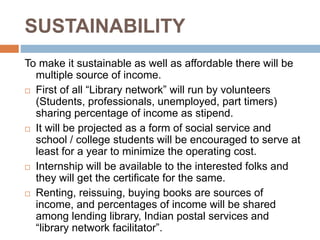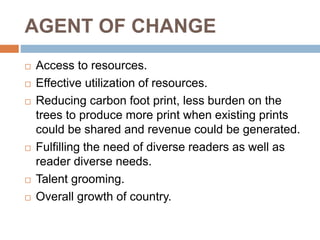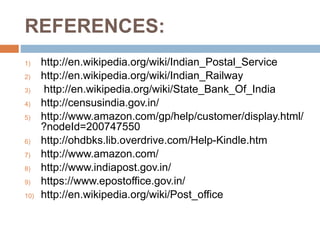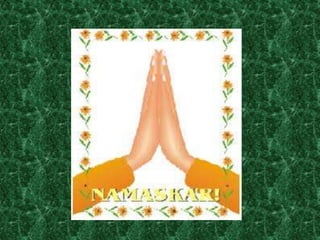iLibrary - Library system for masses
- 1. I LIBRARY, MY LIBRARY, OUR LIBRARY: TOUCHING LIVES OF BILLION PEOPLE SUNEET SHARMA SCHNEIDER ELECTRIC (INDIA)
- 2. Table of Content ’é© Objective ’é© Need ’é© Idea ’é© Methodology ’éż Model1 ’éż Model2 ’éż Model3 ’é© Other Feature / Use cases ’é© Sustainability ’é© Agent of Change ’é© References
- 3. OBJECTIVE Making resource of information available to everyone everywhere and simultaneously making it affordable and sustainable.
- 4. Need ’é© 1.2 Billion population (70% Rural, 30 % Urban) ’é© Poor public library network (That too limited only to cities) ’é© Private library very rare (Unaffordable) & Cater to Specific need of the users. ’é© Academic library (Restricted to students studying there). ’é© Rural Areas (Severe Scarcity of resources of information). ’é© Acquiring skills (By Having access to resource of information) are important that Degree.
- 5. Need to haveŌĆ” AŌĆ”SystemŌĆ” ’é© Where access to Resources of information is not restricted to the Geographical Location (Urban, Suburban, Rural, Semi Rural, Towns, Remote, etc.). ’é© Caters diverse users in their preferred way of connectedness (Mobile, Internet, Physical). ’é© Caters diverse need of the users and need of diverse users. ’é© Which is affordable to common man. ’é© To facilitate full Utilization of resources (Resources lying in the library while there are users who desperately need it, are complete waste). ’é© To help one in honing oneŌĆÖs skills.
- 6. IDEA A well-managed library network, which provides every one equal access to resources of information and that too at very affordable price. But How? First letŌĆÖs understand ŌĆ£Satellite theory of ResourcesŌĆØ
- 7. Satellite theory of Resources Internet, online stores, etc. are mobilizing the resources where ever the needs are unlike traditional ways, where users have to approach resources, users need to go to them.
- 8. Implementing - Satellite theory ’é© Idea is to mobilize resources with minimal cost and make it accessible to masses at lower cost but profitable at the same time. ’é© Interconnecting all the libraries (Public, private, academic) and making complete resource utilization. ’é© India is having close to 600000 villages, 4500 towns and 650 districts (1.2 Billion population), It is almost impossible to build the library network to such a such a big and diverse country, so we need to look at the existing networks which have reach in the nooks and corners of India and building on top of that.
- 9. IndiaŌĆÖs 3 biggest network: ’é© Indian postal services: As of 31 March 2011, the Indian Postal Service has 154,866 post offices, of which 139,040 (89.78%) are in rural areas and 15,826 (10.22%) are in urban areas. On an average, a post office serves an area of 21.23 sq;km and a population of 7,114 people. This is the most widely distributed post office system in the world. ’é© Indian Railway: It is one of the world's largest railway networks comprising 115,000 km (71,000 mi) of track over a route of 65,000 km (40,000 mi) and 7,500 stations. ’é© State bank of India: As of March 2012, it had assets of US$360 billion and 14,119 branches, including 173 foreign offices in 37 countries across the globe. Including the branches that belong to its associate banks, SBI has 21,500 branches.
- 10. Methodology: Model-1 (By Indian postal services): Why (Indian Postal Services) ’é© Can harness the widest reach of Indian postal services which will work as a transit library. ’é© In General each and every region in Indian map is connected to respected post office. ’é© Post offices offer mail related services posting, receipt, sorting, handling, transmission or delivery of mail, such as letters, small packages, and usually money (Ready made network). ’é© Post office will work as a connecting thread with other libraries falling under those post offices. ’é© Post office will facilitate in making an efficient supply chain and there will be efficient control on time to delivery.
- 11. Methodology: (Model 1 ŌĆō Postal Service) How it will work: Transaction is a 5 steps process. All the steps evolve around user who want the access to resources of information. 1. Need a book 2. Find book 3. Borrow / Rent / Buy / Lend 4. Read 5. Return LetŌĆÖs Understand each step with respect to First model.
- 12. Methodology: (Model 1 ŌĆō Postal Service) Transaction (Different Steps): 1- Need a book: Individuals own requirement, but visiting nearby post office and going through the catalogue definitely can inspire you. 2- Find book: Each post office will be having printed as well as softcopy of the catalogue which will be having information about different books category wise. This list will be of course dynamic and will be updated regularly. In printed version we will keep adding pages as per the catalogue update (Sort of spiral binding ’āĀ which makes easy to add and remove pages to update).
- 13. Methodology: (Model 1 ŌĆō Postal Service) Transaction (Different Steps): 3- Borrow / Rent / Buy / Lend: ’é© At Post office one can buy library card (Value 10 INR = .2$) to order the book. ’é© Request goes to the nearest zonal office (Or it could be the same post office), where availability of the requested book in different libraries is checked and request is forwarded to the nearest partner libraries* where the book is available. *Partner library - Not only libraries (private, public, academic) but any individual/group), publication house can become ŌĆ£Partner libraryŌĆØ.
- 14. ’é© Any individual/group (Provided they have good collection and wanted to share and earn on the same) can become partner library. ’é© Even publication houses can become partner library and they can earn revenue without printing books, but reaching to all the users. *Preference is given the respective partner library which is nearest to the user. ’é© Partner library Lending library gets its commission for the each book (some percentage of amount charged to the user). Lending library drops the book back to post office (Tearing the appropriate section of the form) from there it getŌĆÖs delivered to the user which after reading user drops back to the nearest post office from there it goes back to the respective lending library.
- 15. Methodology: (Model 1 ŌĆō Postal Service) Transaction (Different Steps): 4- Read: ’é© Person will read the book as per his / her discretion, however books could be reissued and for the same individuals need to post the ŌĆ£reissue library cardŌĆØ, which will go the respective lending library for the approval and the user will get intimation from the lending library whether the same could be reissued or not. ’é© User can also purchase the book by posting the ŌĆ£purchase library cardŌĆØ along with the money order equal to the book cost and the book will be delivered to the user.
- 16. Methodology: (Model 1 ŌĆō Postal Service) Transaction (Different Steps): 5- Return: ’é© Government of India is planning to UID (unique identification number) for each citizen, and UID itself be used as a library card no separate ID needed however user need to register to the respective post office if that will be centre of transaction for borrowing and returning books. ’é© Each transaction will be tracked by UID if a person fails to return on time, he/she will get warning notification and still he/she fails, fine will start accumulating in his account (.5 INR per day) and he/she will be black listed and canŌĆÖt borrow further until he/she clears his/her previous dues.
- 17. Other Parallel Model - Methodology: (Model 2 ŌĆō Mobile phone) ’é© As by June 2012 in India mobile penetration is around 51% which is expected to go up by 75% by 2016. ’é© Connectivity through mobile is increasing every day and even rural India is well connected in the worst cases there will be at least a person having mobile phone in every village. ’é© Lot of paper work could be avoided and information could easily and rapidly flow.
- 18. Methodology: (Model 2 ŌĆō Mobile phone) Transaction (Different Steps): ’é© 1- Need a book: Needing a book is always a user requirement but user can always access catalogue in his mobile to fine tune his requirement. 2- Find book: Hence finding a book
- 19. Methodology: (Model 2 ŌĆō Mobile phone) Transaction (Different Steps): 3- Borrow / Rent / Buy / Lend: ’é© Physically going to the post office is one way but definitely not the only way, Phone users can buy ŌĆ£Library creditŌĆØ and order book by SMS and money will be deducted from their phone account. ’é© Remaining process will remain same, requirements going to the lending library and from there physical book is going to the user and back to the lending library using postal services as a medium. Here there will not be any physical movement of the library card, communication flow will happen through mobile only. ’é© Here the preference will be given to nearest partner library who is more prompt in confirming the book availability. ’é© They can even buy books by using ŌĆ£Library creditŌĆØ.
- 20. Methodology: (Model 2 ŌĆō Mobile phone) Transaction (Different Steps): 4- Read: ’é© One thing is the physical movement of the book to the users however other thing book could also be sent to the respective user in electronics format to his mobile if the user has activated the library service in his mobile (But no doubt reading experience will not be great due to small screen and navigation of pages).
- 21. Methodology: (Model 2 ŌĆō Mobile phone) Transaction (Different Steps): 5- Return: ’é© One thing is the physical movement of the book back to the lending library. But if the user has opted for library service and received book in electronic format then the link will be deactivated after predefined time as per the terms and conditions so he/she no longer can use it. But he/she can renew with very minimum charge or even can permanently store case to case basis (As some books are even free, there is no need to pay for them apart from data usage charge). But user can of course buy books and there is no need of returning of the same.
- 22. Other Parallel Model - Methodology: (Model ŌĆō Internet Users) ’é© Today penetration of internet is 10% and is growing every day. ’é© There is always option to read book on the device itself hence avoiding printed version. ’é© Lot of possibility of interaction, online guidance etc.
- 23. Methodology: (Model 3 ŌĆō Internet User) Transaction (Different Steps): 1- Need a book: Needing a book is always a user requirement but user can log on to the website and narrow down his search. 2- Find book: Hence finding the book desired. 3- Borrow / Rent / Buy / Lend: User can do the transaction for printed (For physical books process will remain as explained earlier) as well as eBooks. User has to pay by credit / debit card.
- 24. Methodology: (Model 3 ŌĆō Internet User) Transaction (Different Steps): 4- Read: ’é© One thing is the physical movement of the book to the users however other thing is user will receive the book in electronic format. *Presently governments spend millions of rupees in providing printed books and this cost is recurring every year to every student. While in the same cost tablet, could be provided with free course eBooks. However tablets will be specifically designed keeping userŌĆÖs reading habits in mind.
- 25. Methodology: (Model 3 ŌĆō Internet User) Transaction (Different Steps): 5- Return: ’é© One thing is the physical movement of the book back to the lending library. But if the user has opted for eBooks then the link will be deactivated after predefined time as per the terms and conditions so he / she no longer can use it. But he/she can renew with very minimum charge or even can permanently store on case to case basis (As some books are even free, there is no need to pay). But user can of course buy books and there is no need of returning of the same.
- 26. OTHER FEATURES / USE CASES ’é© Post offices will work as a transit library where there will be a dedicated space defined for the library or it could be different building which is connected to the respective post office (If post office doesnŌĆÖt have enough space to facilitate library service). Even the existing public library or any other municipality building can be a transit library but it has to be connected to the respective post office. ’é© This model will also help in building community libraries at least in connecting dots. Group of community library will be connected to the respective post offices. ’é© Anyone can send books to his/her friend on returnable basis (Sharing on the condition that you return). People can get specially designed envelope along with ŌĆślibrary stamp on condition that you returnŌĆØ (Special stamp which facilitate 2 way transaction sending and returning from door to door) and dispatch book which reader can drop back to the post office or drop box after reading or postman will pick from his home after the predefined interval or when reader intimates the post office.
- 27. ’é© Anyone can be part of library network to earn money on the resources which are lying unused, one way you are doing charity by making it available to the masses and simultaneously earning on the same. Interested people need to approach the respective post office giving book details. ’é© This will be place for information and guidance to excel in the art you want to excel. ’é© Carrier counseling (Given by Volunteers) ’é© Workshops (Given By Volunteers) ’é© News of current affairs / technology / news paper ’é© Competitions and special events could be organized ’é© Special sessions (For differently enabled people) ’é© Sessions (On Language, etc...)
- 28. SUSTAINABILITY To make it sustainable as well as affordable there will be multiple source of income. ’é© First of all ŌĆ£Library networkŌĆØ will run by volunteers (Students, professionals, unemployed, part timers) sharing percentage of income as stipend. ’é© It will be projected as a form of social service and school / college students will be encouraged to serve at least for a year to minimize the operating cost. ’é© Internship will be available to the interested folks and they will get the certificate for the same. ’é© Renting, reissuing, buying books are sources of income, and percentages of income will be shared among lending library, Indian postal services and ŌĆ£library network facilitatorŌĆØ.
- 29. ’é© Availing special service like sending books ones friend on returnable basis. Forthat person has to buy ŌĆ£library stamp on condition that you returnŌĆØ (Special stamp which facilitate 2 way transactions sending and returning from door to door). ’é© We anticipate mass transaction, which will minimize the average operating cost and at the same time will increase the income. (Actual figures will be shared in the full paper). ’é© Money raised from workshops, events, competitions, special sessions etc. (Amount will be affordable, but at the same time will be good enough to have at least 30% net earnings after cutting down all the operating expenses. ’é© There will not be any hierarchy in the organization, all volunteers have to work equally and even stipend also will be as per the earning of the Area with adjustment if it goes to either extreme.
- 30. AGENT OF CHANGE ’é© Access to resources. ’é© Effective utilization of resources. ’é© Reducing carbon foot print, less burden on the trees to produce more print when existing prints could be shared and revenue could be generated. ’é© Fulfilling the need of diverse readers as well as reader diverse needs. ’é© Talent grooming. ’é© Overall growth of country.
- 31. REFERENCES: 1) http://en.wikipedia.org/wiki/Indian_Postal_Service 2) http://en.wikipedia.org/wiki/Indian_Railway 3) http://en.wikipedia.org/wiki/State_Bank_Of_India 4) http://censusindia.gov.in/ 5) http://www.amazon.com/gp/help/customer/display.html/ ?nodeId=200747550 6) http://ohdbks.lib.overdrive.com/Help-Kindle.htm 7) http://www.amazon.com/ 8) http://www.indiapost.gov.in/ 9) https://www.epostoffice.gov.in/ 10) http://en.wikipedia.org/wiki/Post_office

